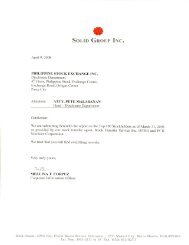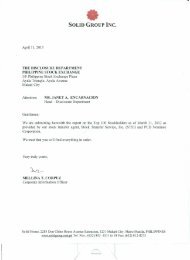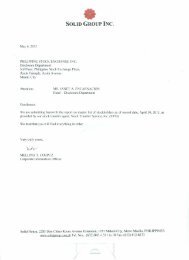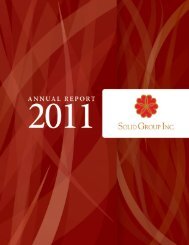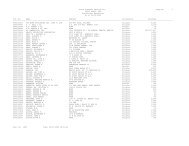SEC Form 17-A: Annual Report - the solid group inc website
SEC Form 17-A: Annual Report - the solid group inc website
SEC Form 17-A: Annual Report - the solid group inc website
You also want an ePaper? Increase the reach of your titles
YUMPU automatically turns print PDFs into web optimized ePapers that Google loves.
- 29 -<br />
(d)<br />
Dist<strong>inc</strong>tion Between Investment Property and Owner-managed Properties<br />
The Group determines whe<strong>the</strong>r a property qualifies as investment property. In<br />
making its judgment, <strong>the</strong> Group considers whe<strong>the</strong>r <strong>the</strong> property generates cash<br />
flows largely independent of <strong>the</strong> o<strong>the</strong>r assets held by an entity. Owner-occupied<br />
properties generate cash flows that are attributable not only to <strong>the</strong> properties but<br />
also to o<strong>the</strong>r assets used in <strong>the</strong> production or supply process.<br />
Some properties comprise a portion that is held to earn rental or for capital<br />
appreciation and ano<strong>the</strong>r portion that is held for use in <strong>the</strong> production and supply<br />
of goods and services or for administrative purposes. If <strong>the</strong>se portions can be<br />
sold separately (or leased out separately under finance lease), <strong>the</strong> Group accounts<br />
for <strong>the</strong> portions separately. If <strong>the</strong> portion cannot be sold separately, <strong>the</strong> property<br />
is accounted for as investment property only if an insignificant portion is held for<br />
use in <strong>the</strong> production or supply of goods or services or for administrative<br />
purposes. Judgment is applied in determining whe<strong>the</strong>r ancillary services are so<br />
significant that a property does not qualify as investment property. The Group<br />
considers each property separately in making its judgment.<br />
(e)<br />
Fair Value Measurement of Investment Property<br />
The Group’s investment property composed of parcels of land and buildings and<br />
improvements are carried at revalued amount at <strong>the</strong> end of <strong>the</strong> reporting period.<br />
In determining <strong>the</strong> fair value of <strong>the</strong>se assets, <strong>the</strong> Group engages <strong>the</strong> services of<br />
professional and independent appraisers. The fair value is determined by<br />
reference to market-based evidence, which is <strong>the</strong> amount for which <strong>the</strong> assets<br />
could be exchanged between a knowledgeable willing buyer and seller in an arm’s<br />
length transaction as at <strong>the</strong> valuation date. Such amount is influenced by different<br />
factors <strong>inc</strong>luding <strong>the</strong> location and specific characteristics of <strong>the</strong> property<br />
(e.g., size, features, and capacity), quantity of comparable properties available in<br />
<strong>the</strong> market, and economic condition and behavior of <strong>the</strong> buying parties.<br />
A significant change in <strong>the</strong>se elements may affect prices and <strong>the</strong> value of <strong>the</strong><br />
assets. The amounts of revaluation and fair value gains recognized on investment<br />
property are disclosed in Note 13.<br />
(f)<br />
Dist<strong>inc</strong>tion Between Operating and Finance Leases<br />
The Group has entered into various lease agreements as ei<strong>the</strong>r a lessor or lessee.<br />
Critical judgment was exercised by management to distinguish each lease<br />
agreement as ei<strong>the</strong>r an operating or finance lease by looking at <strong>the</strong> transfer or<br />
retention of significant risk and rewards of ownership of <strong>the</strong> properties covered<br />
by <strong>the</strong> agreements. Failure to make <strong>the</strong> right judgment will result in ei<strong>the</strong>r<br />
overstatement or understatement of assets and liabilities. Based on management<br />
judgment, such leases were determined to be operating leases.<br />
(g)<br />
Recognition of Provisions and Contingencies<br />
Judgment is exercised by management to distinguish between provisions and<br />
contingencies. Policies on recognition of provision and contingencies are<br />
discussed in Note 2.14 and <strong>the</strong> disclosures on relevant provisions and<br />
contingencies are presented in Note 28.



